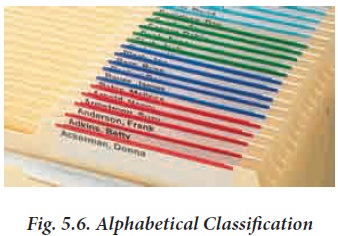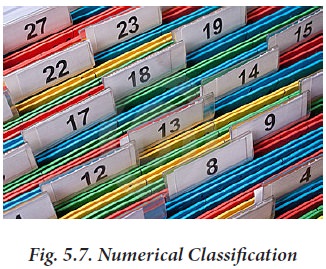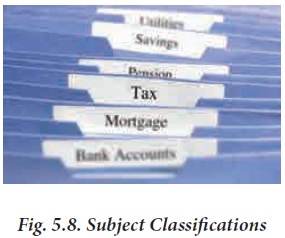Office Filing and Indexing - Classification of Files | 11th Office Management and Secretaryship : Chapter 5 : Filing and Indexing
Chapter: 11th Office Management and Secretaryship : Chapter 5 : Filing and Indexing
Classification of Files
Classification
of Files:
There
are five methods of classification. They are:
1.
Alphabetical
Classification
2.
Numerical
Classification
3.
Geographical
Classification
4.
Subject
Classification and
5.
Chronological
Classification.
1. Alphabetical Classification:
Alphabetical classification is based on the
occurrence of the letters in the alphabet as it is done for the dictionary.
Telephone
directory is another example. If several names occur having the first letter,
the arrangement takes into account the subsequent letters also, for example:
A,
AB, AC ----------- etc
B,
Bb, BC ------------- etc.
Under
the alphabetical classification, the filing of papers and documents is either
by the names of the correspondents or the subjects. In a large office, it would
be proper if 26 letters of the English alphabet are divided into small equal
parts considering the letters which are bound to have more names. This method
of classification can be used in correspondence filing, contracts, orders and
staff records.

2. Numerical Classification
In
this method of classification, each folder or record is given a number, and the
files are placed in strict numerical order. For example Mr. Gnanasekar Ltd, may
be assigned No 25. If they deal in a number of lines, each line may be
classified with a number beginning with 25, for example, 25.1, 25.2, 25.3,
etc.,
The
system of numerical classification is generally recommended for filing of
orders, sales, invoices, contracts, (where numbered) and committee minutes.

3. Geographical Classification
As
the name implies, this classification is based on the geographical origin of a
document or paper. This system is combined with one of the two systems already
discussed. The classification can be town-wise, district-wise, state wise,
country-wise and continent-wise.
The
steps in geographical classification are outlined as follows:
(i).
First of all geographical limits are set and areas are defined which will make
one unit, for example, in export-import trade
(ii).
Next step will be to arrange these countries in their alphabetical order, for
example, Algeria, Bolivia, Canada, France, Great Britain, USA and USSR, etc.,
(iii).
Within each sub-division classification of different parties may be arranged
alphabetically or numerically. Such method of classification is very useful for
customers’ orders in a given area and for filing of correspondence according to
town.
4. Subject Classification:
It
is a method of classification in which all documents relating to a subject are
brought together in one file, even though they may have come from different
sources and from many different people. Following steps are taken to install
subject classification
1.
Defining Subject
2.
Sub-dividing subjects into smaller fractions
3.
Assigning numbers or arranging subjects in alphabetical order, including
sub-subjects, and
4.
Miscellaneous folders are made for subjects which have not been classified.
Example:
Main
Subjects Classified:
Purchases
Sales
Advertising
Sub-division
of classified subjects:
Purchases
-------------- Scooter Parts.
Purchases
------------- Tractor parts.
Purchases
-------------- Motor Parts

5. Chronological Classification
Under
this method various records are identified and arranged in strict date order
and sometimes even according to the time of the day. It is a useful method for
filing invoices and other vouchers associated with accounts.
This
system may be useful if used along with some other system. The records may be
arranged alphabetically first and then can be arranged date-wise within each
folder. So this system cannot be used independently.

Related Topics